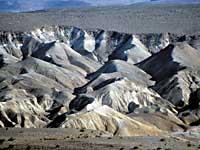When there is hype, when there is no... influence

Rain is part of the water cycle in nature. Water vapor from the seas and oceans condenses and forms clouds such as evaporation and plant respiration. Hot and humid air rises and when it reaches high altitude, water vapor condenses and drops form, even ice crystals at very high altitudes.
As droplets are very small, they are in balance in the air, but they begin to come together and get bigger. When they reach a certain size, exceeding 0.5 millimeters, they become too much for air currents and begin to fall. It rains.
Removing water from mists
This would be about a rain process. It is easy to explain, not so much to copy. Beyond dances and laughter to provoke rain, man has often tried to artificially influence rain, but so far has not achieved total success. However, there are some achievements.

The starting point for the artificial obtaining of rain are the clouds, the bombardment of them. Silver ioduro is used in bombing, either by plane or missile. These duly sprayed substances produce condensation zones. These cores catch the droplets from the clouds and fall down.
In addition to silver ioduro, carbon snow – ice cream carbon dioxide – or ice crystals have been used in the same way and for the same purpose. This substance has also managed to cause rain, but the results have not been so good. The same substance is a little more natural. All these techniques have begun to be used in the 1970s.
With these systems, rain has been achieved and caused. But it cannot be said that it is a success, on the one hand because rain is not always achieved, because it is not guaranteed, and on the other, because it is very expensive. New lines of research have been opened in the generation of artificial rain.
Forming mists
To achieve rain artificially, the participants of an international project turn to the source by abandoning the war strategy of the bombings to create clouds artificially. The Free University of Brussels, Ben Gurion University of Israel and NASA are part of the Geshem project, with rain in Hebrew. They want to use black plates. The plates would absorb heat from the sun's rays, allowing water to evaporate, resulting in artificial mists. The pilot project located in the desert of Israel is underway for next year.

The scientific basis of the project are the islands of heat, areas with temperatures much higher than those of the environment. These areas cause the rise of hot air with water vapor, water condensation and the formation of mists in the surroundings. This phenomenon is XX. He highlighted especially in the twentieth century when cities grew at full speed and perfection. It is believed that this also caused weather changes, including increased rainfall. Researchers cite the American city of Los Angeles as an example.
Through dark plates, Geshem pretends to simulate the phenomenon of heat islands. The pilot project aims to cover two kilometers of surface and reach high temperatures that facilitate the expansion of air and steam. Theoretically, the surrounding steam will rise upwards, starting to cool, condensing, forming mists and starting rainfall.
Right now, researchers are looking for the most suitable material to make the plates. This material should easily absorb heat, be biodegradable to avoid pollution and be economical, otherwise it would not be profitable. Once the most suitable material is selected, the plates will be placed. In this case they have chosen the Negev desert because it is near the sea. In fact, for the project to succeed, researchers believe that wet areas, with high water vapor density, must be relatively close, at a maximum distance of 100 or 150 kilometers.
Use of rain

Why does man want to dominate the weather, in this case the rains? The majority responses would be to address droughts, address water scarcity, meet the needs of agriculture, etc. And yes, for that yes, but not just for that. It is also being used to the contrary. That a lot of fog is accumulating, that too strong squalls are expected, that there is danger of breaking down the stone… causing rain and solving the problem.
Silver ioduro rains have also been used to combat air pollution, especially in urban areas. Rain is excellent for cleaning the air and in some cases has been the only solution to eliminate pollution.
But, as has already been said, in most cases, attempts to get rain artificially aim to cope with droughts. And we still have to talk about trials, because although they are being used daily and already have a few years, the techniques do not guarantee rain. The current project remains a project. Within a few years it will be something else, or perhaps not, from the scientific point of view.
Other problems
Costly and unsafe techniques of artificial rain action. But there are more problems, is it sure that it rains? Beijing is a good example.

The 2008 Olympic Games will be held in Beijing. Although the “green games” were announced, in recent years the drought is huge. In view of this, in recent years the authorities have given the order to use techniques to artificially influence the rain. Beijing already has “the era of artificial rains” between July and September. Last year, 23.77 million cubic meters of water were obtained. This year the season has lasted from April to September, exceeding last year. All with silver iodine. The truth is that, despite the severe drought, it occasionally also expels rain naturally, causing flooding due to the strong imbalance.
The use of artificial techniques to obtain rain has also generated problems alien to science. Whose clouds are? China, which is so big, has reported it. Last July, Henan province in central China dominated the canyon noise. From the city of Luohe 765 bombs were dropped in a single day against a group of mists. The rainfall was 50 millimeters in the city itself and 81 millimeters in the surroundings. When the fog set began to move, from four other cities gunshots were thrown to cause rain.
In one of the cities they managed to collect 100 millimeters of water, less in another two and 27 millimeters in the fourth. Thanks to the rain they managed to relieve the drought a little, but the result did not leave everyone satisfied because some received more water than others. China has no legislation on atmospheric resources, so its inhabitants are discussing. They have spent a lot of money on crafts and resources and have not obtained the expected results. If, instead of between cities, the question would have happened between countries?





